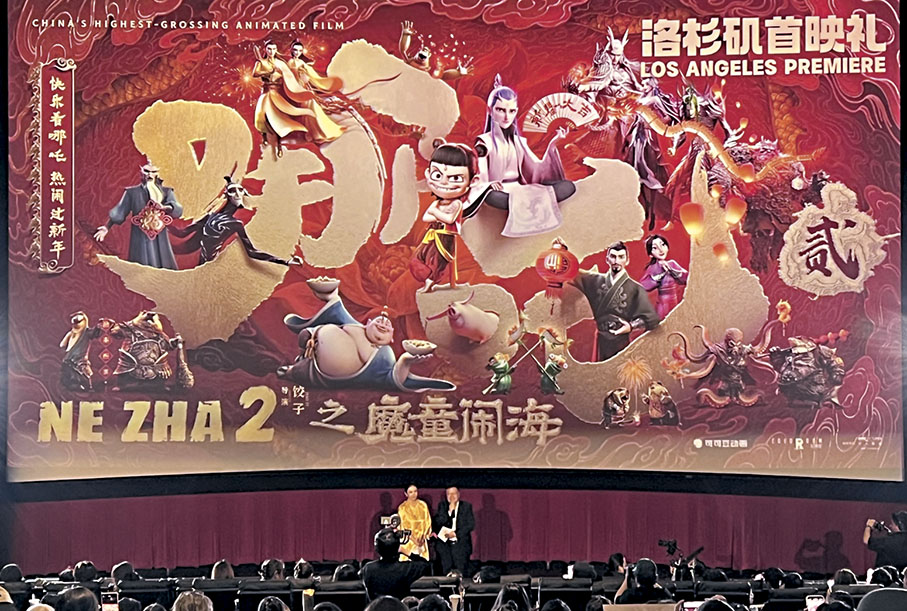【社評雙語道】「哪吒出海」弘揚中華文化

【原文】摘錄自2月14日香港《文匯報》:電影《哪吒之魔童鬧海》(《哪吒2》)在內地廣受觀眾歡迎,上畫至2月13日,總票房已突破100億元人民幣,成為唯一一套非荷里活電影進佔全球影史頭二十位,而今「哪吒」乘「風火輪」駕臨香江。
2月13日,有影片發行商宣布,將於香港及澳門發行《哪吒2》,分別在多家影院放映。我國影視製作人員心思十足,結合我國古代經典鉅著,運用現代動畫製作科技,精彩呈現中國神話故事,展示中華文化的迷人魅力,引起世人對中華文化的嚮往和興趣。香港更要借助中外文化薈萃的優勢,製作、傳播更多中華文化的優秀作品,為建設中外文化藝術交流中心賦予更豐富內涵,向世界講好中國故事、香港故事。
《哪吒2》自今年1月29日即年初一在內地上映後,有口皆碑,票房節節上升。導演餃子攜原班人馬與來自全國近140個團隊、超過4,000位動畫人鼎力合作,歷時五年製作,將中國動畫電影創作帶向新高峰。電影延續了《哪吒1》的喜劇風格,角色數量更是《哪吒1》的三倍,而特效鏡頭數量更已超越《哪吒1》的全片鏡頭總數,印證了我國動畫技術更趨成熟。
哪吒的故事源自明代神魔小說《封神演義》,曾經多次被改編為影視動漫作品,本港電視台在1986年和2001年製作的《哪吒》和《封神榜》劇集,至今仍為人津津樂道。哪吒活潑而正義的形象深入民心,尤其吸引青年人。這次內地劇組製作《哪吒2》,以最新動畫科技演繹原著的神魔世界,為觀眾帶來新鮮感。不少海外觀眾都引頸以盼影片在海外發行,輿論紛紛預測,影片勢將在國際電影市場取得佳績。
除了《哪吒2》外,以《西遊記》為題材的電腦遊戲作品《黑神話·悟空》此前也在國際上引起轟動。有關中國傳統故事的影視娛樂作品近期獲得海內外受眾垂青,一方面是由於作品極盡視聽感官刺激,另一方面是製作團隊具備深厚的文學與歷史底蘊,還有對經典文學作品有獨到的見解,通過大眾娛樂平台把心中所想的世界具象化呈現。
有專家認為,中國文化出海已經取得了相當大的成績,他們相信隨着中國科技、文化產業等領域的不斷發展,未來會有更多優秀中國文化產品走向世界。
《哪吒2》在內地放映熱爆,推動全球對中國元素及中國動畫的關注,對推廣中國文化起積極作用,無疑相當成功。
不過,要影片走出海外,則需要顧及到海外觀眾對中國名著未必十分了解。藉着影片,通過短視頻、文字分享,由網紅通過小紅書等平台解說,製造話題,增加觀眾對哪吒和《封神演義》的故事的了解,增進對中國傳統經典文學的興趣,積聚更多中國文化愛好者,將使中國文化的弘揚更上一層樓。
《哪吒2》、「黑神話·悟空」,以及去年由深圳歌舞劇院呈獻的《詠春》舞劇等作品取得空前成功,作為中外文化薈萃之地的香港也受到啟發。過去香港電影界曾經製作出《黃飛鴻》等展現民族氣節的作品,又有金庸武俠小說、唐滌生經典粵劇戲寶,俱蜚聲海外。我國弘揚中華文化、促進文明互鑒的水平至今已趨成熟,藉着《哪吒2》在港放映,香港應不落人後,思考下一步傳播中華文化之路,例如集政府與企業資源,設基金與平台鼓勵年輕一代開發原創作品,以新穎方式演繹中華文化,以此培養新一代文創人才,為建設「中外文化藝術交流中心」賦予更豐富的內涵。
3D animated Ne Zha goes global to champion Chinese culture
【譯文】The film Ne Zha: Mo Tong Nao Hai (The Devil Child Stirs the Sea), known as Ne Zha 2, has won over audiences in mainland China, with its box office takings surpassing 10 billion RMB as of 13 February, making it the only non-Hollywood film to break into the top 20 global cinematic earners. Soon, "Ne Zha" will ride his "wind-and-fire wheels" to Hong Kong.
On 13 February, a film distributor announced that Ne Zha 2 will be released in Hong Kong and Macao, screening across multiple cinemas. Chinese filmmakers have poured their hearts into this project, blending ancient literary classics with cutting-edge animation technology to vividly bring Chinese mythology to life. This showcases the captivating allure of Chinese culture, sparking global admiration and curiosity. Hong Kong, with its unique blend of Eastern and Western influences, must seize this chance to produce and share more outstanding works of Chinese culture, enriching its role as a hub for international cultural and artistic exchange while telling compelling stories of China and Hong Kong to the world.
Since its release in mainland China on 29 January, the first day of the Lunar New Year, Ne Zha 2 has earned widespread praise and seen its box office figures soar. Director Jiaozi (meaning 'dumpling'), together with the original cast, worked with nearly 140 teams and over 4,000 animators from across China for five years to produce the film, bringing Chinese animated film creation to new heights. The film retains the comedic flair of Ne Zha 1, boasting triple the number of characters and a tally of special effects shots that exceeds the total shot count of its predecessor, underscoring the growing maturity of China's animation technology.
The tale of Ne Zha originates from the Ming Dynasty supernatural novel Investiture of the Gods and has been adapted numerous times into films, TV series, and animations. Ne Zha (The Boy Fighter from Heaven) in 1986 and Gods of Honour in 2001, both produced by local TV companies, remain fondly remembered to this day. Ne Zha's lively and righteous persona has captured hearts, particularly among younger audiences. This time, the mainland Chinese crew behind Ne Zha 2 has harnessed the latest animation technology to reimagine the novel's mythical realm, delivering a fresh experience for viewers. Many overseas fans are eagerly awaiting its international release, with public opinion widely predicting a strong performance in the global film market.
In addition to Ne Zha 2, the computer game Black Myth: Wukong, inspired by Journey to the West, has previously caused a stir internationally. Recent film and entertainment works rooted in Chinese traditional stories have won favour with audiences both at home and abroad. This success stems partly from their thrilling audiovisual appeal and partly from the production teams' deep literary and historical heritage, coupled with unique interpretations of classic literary works. Through mainstream entertainment platforms, they bring their envisioned worlds vividly to life.
Experts believe that Chinese culture's global outreach has already achieved significant success, and with ongoing advancements in China's technology and cultural industries, they predict that more exceptional Chinese cultural products will captivate the world in the future.
Ne Zha 2 has taken mainland China by storm, boosting global interest in Chinese elements and animation while playing a vital role in promoting Chinese culture – a resounding success by all accounts.
However, for the film to succeed overseas, it must address the fact that international audiences may not be familiar with Chinese literary classics. By leveraging the film through short videos and text posts, with influencers explaining the story of Ne Zha and Investiture of the Gods on platforms like Xiaohongshu (RedNote), buzz can be generated. This would deepen viewers' understanding of the tale, spark interest in China's traditional classic literature, and attract more enthusiasts, taking the promotion of Chinese culture to new heights.
The unprecedented success of Ne Zha 2, Black Myth: Wukong, and last year's Wing Chun dance drama by the Shenzhen Opera and Dance Theatre has inspired Hong Kong, a place where Chinese and Western cultures meet. In the past, Hong Kong's film industry produced works like Once Upon a Time in China that showcased national spirit, alongside globally renowned contributions such as Jin Yong's martial arts novels and Tang Ti-sheng's classic Cantonese opera treasures. China's ability to promote its culture and foster mutual understanding between civilisations have matured significantly. With Ne Zha 2 screening in Hong Kong, the city must keep pace and consider its next steps in spreading Chinese culture. This could involve pooling government and corporate resources to establish funds and platforms, encouraging the younger generation to create original works that reinterpret Chinese culture in innovative ways. Such efforts would nurture a new wave of creative talent, enriching Hong Kong's role as an East-meets-West Centre for International Cultural Exchange.
● Tiffany
